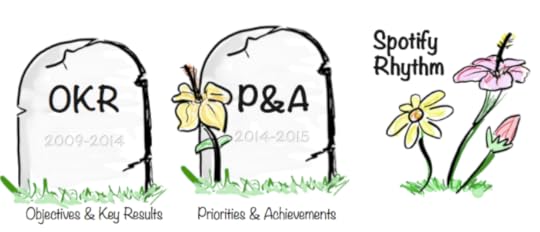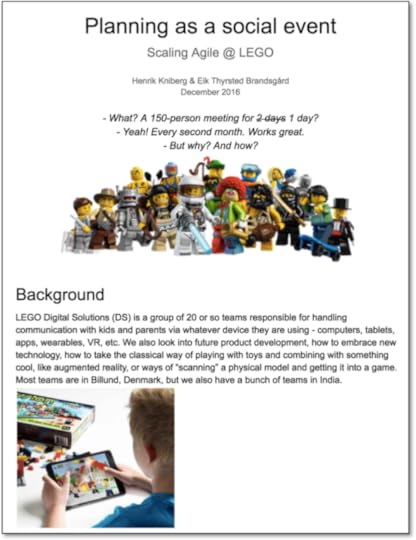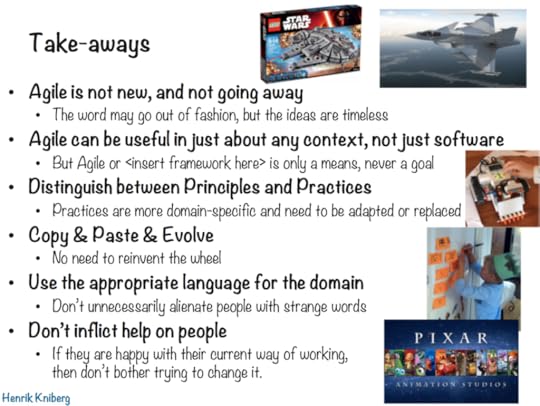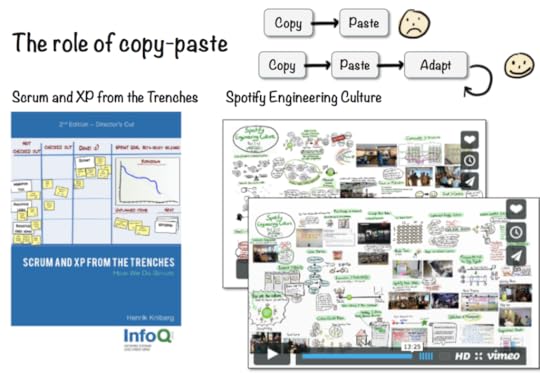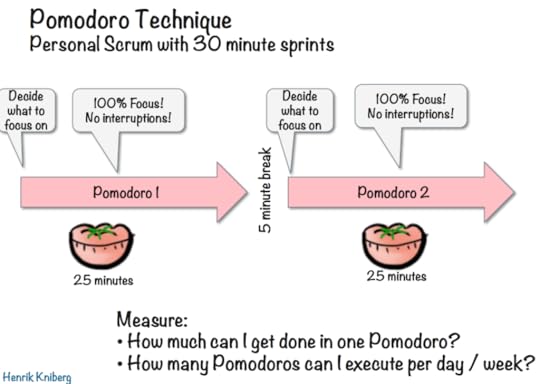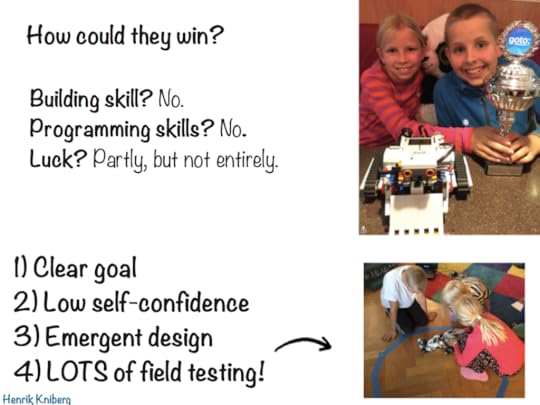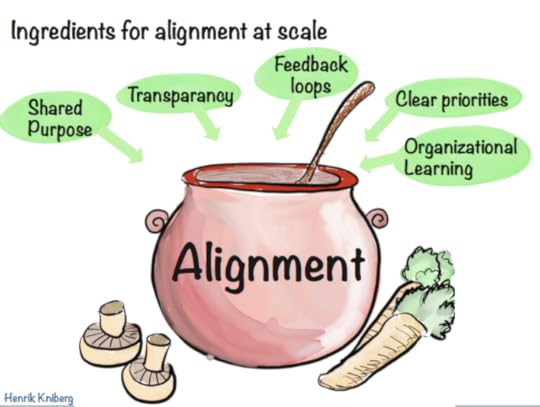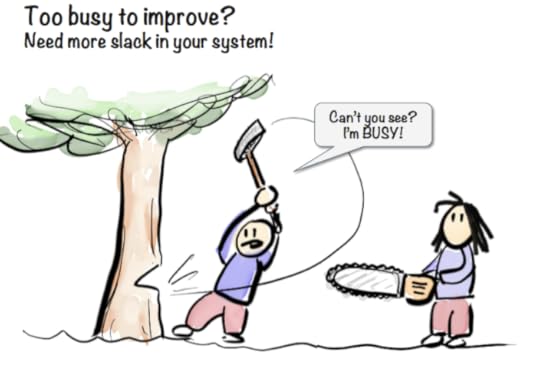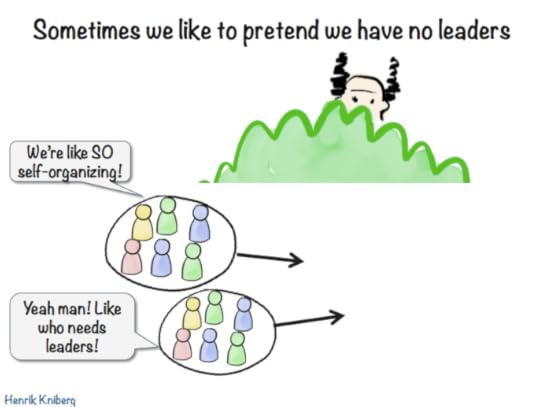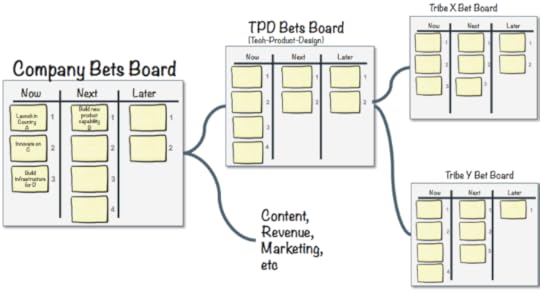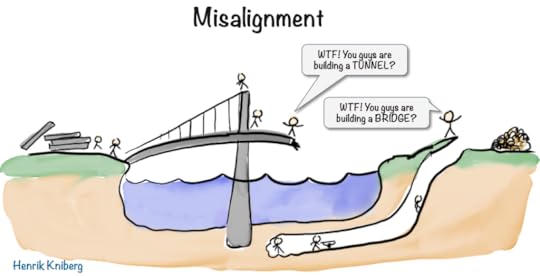Henrik Kniberg's Blog, page 3
February 28, 2017
10 years of Agile @ Crisp. Next challenge: Global Warming!
10 years ago, 2007, me and a few Crisp colleagues embarked on a mission: be best in Sweden at helping companies become agile. We had experienced first-hand the power of agile development, and wanted to use this newfound super-power to help both Crisp and our clients improve. Others joined us and – tadaa! – Agile Crisplet was born (and the concept of crisplets)! That was the year I taught my first Certified ScrumMaster course together with Jeff Sutherland, co-creator of Scrum. Since then we’ve co-trained almost 30 courses! About 2-3 times per year. In fact, May 22-23 is our 10 year anniversary (join us at the course in Stockholm!).
Now 10 years has passed since our Agile Crisplet was formed, and I’m happy to see we have succeeded more than we ever could have dreamed!
Dispensing with false humility here, we’ve somehow managed to become one of the world leaders in this field! Famous agile and lean experts partner with us. Super well-known product companies, large telecoms and banks, even government organizations, turn to us as first choice for agile guidance and training. Our videos and articles and books have racked up millions of hits, and we are basically overwhelmed with requests to do coaching, write book forewords, do conference talks and workshops, and run training courses. I’ve done almost 30 keynotes in 20+ countries. I’m amazed (and overwhelmed) every time I look at my inbox, I’ve had to hire an assistant just to turn down the 95% of all requests that we simply don’t have capacity to handle.
OK, so now what?
10 years is a long time, and now it’s time for a new focus! At least for me (Crisp is a no-CEO company where people are free to do whatever they want).
My personal mission has been “Help companies improve”, then it shifted to “Help the Good Guys Win”. I’ve been focusing on companies that have a good culture and build products that make the world a better place – companies like Spotify and LEGO. “Good Guys” in my book.
But I’ve gotten a little bit too comfortable in my role as “Agile Guru” (I don’t really like the term, but so many people call me that so I’ve decided to just accept it). My work started feeling repetitive, like I was doing things out of habit rather than out of passion. And at the same time, I was getting increasingly worried about global warming, especially after a climate change denier took the helm of one of the most powerful countries in the world.
And then it hit me. Shit! I’m solving the wrong problem! Here I am, feeling good about myself for helping cool, successful companies become even more cool and successful. And at the same time, the world is facing an unprecedented disaster, the sixth mass extinction event over the past 500 million years, caused by humans, and I’m doing nothing at all about it (in fact, making it worse by flying all over the place)! We like to take our existence for granted, but the dinosaurs ruled the earth for 160 million years (800 times longer than the human era so far!), and they were wiped in the last extinction event 65 million years ago. How can I look my children in the eyes, while we screw up the planet they are inheriting?
Over the years I’ve built up this wonderful arsenal of problem solving skills, so how about I use it to help solve the right problem instead? I started studying up on global warming, and realized that this really is the world’s biggest and most important problem, anything else seems tiny and insignificant in comparison. Kind of depressing, because what the heck can I do about it, I’m just one guy and a totally newbie on climate stuff.
But then I realized – wait! 10 years ago, I started off as a newbie (well… not an expert at least) on agile, and now my colleagues and I have managed to make a major world-wide impact on how companies work, helped them create more humane work environments, helped them succeed with their projects, helped them build awesome products and organizations. I’ve lost count of the number of people that have said “You changed my life” (for the positive… I think…)! What if we can pull off the same stunt again? A bit optimistic, yes, but worth a try!
We’ve developed a big arsenal of really useful skills – software development, system architecture, viral communication, teaching, facilitation, structured problem solving, community building, and more! AND we’re lucky enough to have some discretionary time and money – most of us don’t have to work full-time just to make a living. So let’s put it to use!
I started looking for solutions. The past two months I’ve been busy. Partnered with experts. Joined a solar energy startup and formed an electricity company. Formed a community – Climate Crisplet (half of Crisp, 20 people, joined almost immediately!). Studied up on CO2 emissions, started blogging about it. Found awesome tools like www.electricitymap.org. Invested in solar panels in Africa via Trine, an awesome startup that is trying to eliminate energy poverty (and reducing global warming as a side effect). Supported development of aviation biofuel. I’m basically exploring the solution space!
My biggest insight is that there is hope! The solutions are out there. Electric cars. Solar and wind energy. Mainly, we just have to stop burning oil and coal. And there is no reason for us to do so anymore, not for energy at least, and not from an economic standpoint either (even if we ignore climate impact, which is massive). A lot of very passionate smart people are at work saving the world. Lots of really cool stuff is happening! But it needs to happen faster, A LOT faster.
So that’s my new mission and focus: Help reduce global warming.
And that really translates to help find ways to reduce global CO2 emissions, which right now translates to help promote solar and wind energy and electric cars! And make oil & coal energy obsolete as fast as possible.
I’m definitely not an expert on this, so I’m trying to learn as much as I can. Exploring ways to make a difference, partnering with others who know more, spreading knowledge, and inspiring others to help out. People like Elon Musk, Bill Gates, and Al Gore are already making a huge difference, but the more people that pitch in the better.
My mantra is every ton counts, because one ton of CO2 is one ton, regardless of where in the world it is reduced. That’s my driving KPI.
Climate Crisplet is a starting point, so join if you are interested! I can’t promise strong leadership, just a gathering point for people that share this interest and are looking for ways to help out and inspire each other.
I have no idea where the journey will lead, but I’m enjoying it so far! After 10 years of being an “expert” it’s very refreshing to get to be a newbie again 
January 5, 2017
Global warming – simplified summary
OK, here’s a (very) simplified summary of what I’ve learned about global warming after digging deep the past few weeks.
Global warming is a major threat to life as we know it. It’s ALOT worse than most people realize.
Global warming is caused (mostly) by increasing CO2 in the atmosphere.
The CO2 increase comes (mostly) from us burning oil & coal (“fossil fuels”). Adds about 20-30 billion tons of CO2 per year.
So we need to (mostly) stop burning oil & coal.
We burn oil & coal (mostly) for electricity and transport. Coal power plants, car/plane/ship fuel, etc.
We want to keep electricity and transport, but we also want to stop global warming, therefore we need to get electricity and transport without burning oil & coal.
We know how to do that (solar, wind, electric cars, etc). The technology has been figured out, and the prices are at the tipping point where oil & coal can’t compete economically.
So now we just need to hurry up and roll out those solutions! Every single reduced ton of CO2 counts.
Unfortunately shit is going to hit the fan either way (because it’s already launched so to speak), but at least we can slow it down, reduce the impact, and buy us some time.
So pull whatever strings you can to help out – technology, policy, economy, communication, etc. Inform yourselves & each other. People have varying degrees of discretionary time, money, knowledge, voting power, contacts, influence, and motivation. But the more people try to help in one way or another, the more difference it will make as a whole.
More info:
http://climate.nasa.gov/
https://www.co2.earth/
https://www.climaterealityproject.org/
https://en.wikipedia.org/wiki/Global_warming
Video: “Clean Disruption – Why Energy & Transportation will be Obsolete by 2030”
Recent Al Gore TED talk: “The case for optimism on climate change”
December 30, 2016
Planning as a social event – scaling agile at LEGO
The past couple of years I’ve been travelling back and forth to LEGO’s HQ in Billund Denmark, helping out with their agile journey. Super interesting! Learned more than we could ever fit in an article, but here’s an attempt to capture at least some of it, written together with LEGO colleague and co-instigator Eik Thyrsted Brandsgård. Enjoy!
Planning as a social event – scaling agile @ LEGO
December 12, 2016
Did the math on my contribution to global warming
I was curious about how many tons of carbon dioxide that my family pumps into the atmosphere (= global warming). Looked at the most direct variables: flying, driving, and home electricity. There are obviously more variables to look at (like beef!), but I’m starting with these three, as the data is readily available and I gotta start somewhere.
Result:
Flying = 5 tons per year
Driving = 4 tons per year
Electricity = 0.5 tons per year
So, almost 10 tons of CO2 per year. Sorry about that, earth and future generations. Good news is that I now know how to reduce it by ALOT!
Some interesting insights along the way:
I thought electricity consumption would be an important thing to optimize. But it’s NOTHING compared to driving and flying (at least not here in Sweden)! No more bad conscience for forgetting to turn off lights and computers.
BIG aha: Buying a hybrid will reduce our carbon footprint by at least 3 tons per year! Because our driving pattern is almost 100% local (carting kids around to school & activities), we’ll almost never need to burn gasoline. Good, cuz I can’t find a fully electric car that fits our big family comfortably. And our current car is breaking down anyway.
Half of my flying footprint has been just going back and forth to Billund in Denmark every month or two (working with Lego). But actually, it would take only 9 hours for me to get there by train. Train is basically zero carbon footprint. So if I continue travelling to Billund I’ll probably to do it mostly by train. First class, working along the way. There, another 2 tons reduced per year!
I was surprised to learn that the electricity I use is clean (from CO2 perspective). 54% hydro, 45% nuclear, 1% wind. Sweden in general has mostly clean electricity.
Despite (4), I’m exploring options to install solar cells on our property. Might not significantly reduce my carbon footprint, but I see it as more a long-term thing. It’s an investment that hopefully will pay off in 10 years or so, it is a way of supporting clean energy in general, and I will learn things along the way. About 10% of Swedens total energy is imported fossil fuel (roughly – hard to find consistent data about it). The more people who use solar energy at home, the less they use the grid, the less dirty electricity Sweden needs to import, the more clean electricity Sweden can export.
So here’s my goal for 2017:
Flying = max 3 tons per year
Driving = max 1 ton per year
Electricity = 0.5 tons per year
Total: 4.5 tons of CO2, instead of 9.5! Not good, but definitely better.
I’m definitely not an expert on these things, but it took just an evening of googling around to learn how to cut my carbon footprint to less than half, without any major lifestyle change. Pretty cool!
I made sure to be picky about the sources of data. No reporters, tabloids, or social media bubbles! Checked multiple sources for everything, and fiddled around in a spreadsheet to double-check the math. But do let me know if I’ve got anything badly wrong (and if so, please include references).
November 21, 2016
Agile Everywhere – slides from my keynote at Agile Tour, Montreal
Here are the slides from my keynote Agile Everywhere at Agile Tour Montreal. In the keynote I shared my experiences from applying agile in lots of different non-software contexts.
Enjoyed the trip! After the conference I spent a day at Ubisoft Quebec to discuss REALLY large-scale agile (like 1000-person video game projects). I see more and more companies applying agile at really large scale and my key takeaway is that, the larger the project is, the more important the agile principles are. For tiny projects any process can pretty much work. Also interesting to see how different types of organizations – such as video game development, banking, and aerospace – arrive at very similar patterns for how to deal with dozens or hundreds of agile teams building a product together. Just keep in mind that big projects are super-risky with or without agile, so your first priority should be to de-scale.
Anyway here are some sample pictures from the keynote.
October 20, 2016
Focus – my keynote at AgileByExample, Warsaw
Here is my slide (yes, it’s just one slide) from my keynote at AgileByExample in Warsaw.
And a couple of photos:

A live demo of flow vs resource utilization. Assisted by my two youngest kids 
August 30, 2016
What is an unconference?
Curious about unconferences? Perhaps you’re thinking of running one? Or maybe you are invited to an unconference or open space, and the organizer sent you this link to describe how it works? If so you’re in the right place!
This doc is a high-level summary. For more details and facilitation instructions, see the ebook How to run an internal unconference.
What is an unconference?
An unconference is basically a conference without predefined topics. There is a high level structure and theme, but actual topics are generated by the participants on the spot, and breakout groups are formed dynamically based on interest and relevance.
If you know what an Open Space is, an unconference is really just an Open Space event with some added structure at the end to make it fit for company-internal events.
This is a pretty awesome format for cases where you want a super-flexible and participant-driven agenda and structure. I’ve been using it for years at Crisp, Spotify, Lego, and other clients, and it tends to spread virally within organizations. I’ve done it mostly with groups of 20-80 people, and people often say things like “all conferences should be like this” or “best conference I’ve ever been to!”
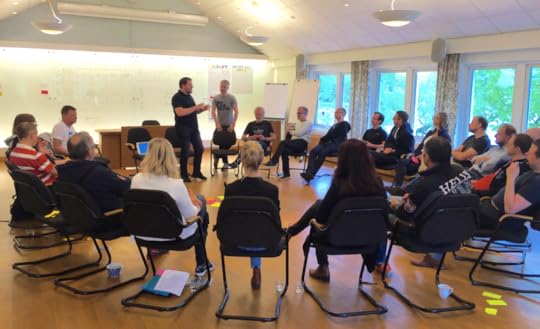
Facilitators opening the circle and introducing the format
Disclaimer: I didn’t invent the term unconference and I don’t own the definition of it. So this is just my take on it.
What are the benefits of this format?
The key benefits of this decentralized setup is:
Higher energy level. People focus on issues that matter to them.
Less up-front planning. No need for someone to set up a detailed agenda ahead of time.
More flexibility. Once we have everyone together, we may discover unexpected topics that are of great interest and importance. With a dynamic agenda, we can capture the moment and maximize the value of the conference.
Spontaneous conversations. Often the most valuable parts of a conference are the informal conversations that happen between people in different teams or roles, who don’t normally work together. People get to know each other, exchange knowledge, and build trust. The open space format encourages this.
If the purpose of a conference is to collaborate and communicate, then an unconference will often fulfill the same purpose in a more simple, fun, and effective way!
What are the potential downsides?
If you have a specific topic that you want people to talk about, or specific decisions that need to be made, then this format might not be ideal (or you’ll at least need to tweak it). Because this type of conference is entirely participant driven, so they choose what they want to talk about, and that might not match what you want. As organizer you only set the overall theme and then let go.
So the question is: To what extent do you really need to control the conversation, and to what extent do you trust people to make best use of their time? If you aren’t sure, try letting go of control just once to see what happens. You’ll probably be surprised!
What? Is there no structure at all?
Actually there is some structure. But bare-bones compared to how typical conferences work.
The organizer defines a Theme. For example “How we will we make this project super-awesome” or “What are our biggest challenges and what will we do about them” or “How does version 2.0 of our company look like?”.
The theme is super-important, because it will attract the right people to the event (and detract the wrong people). So make sure participation is optional. Once you have an inspiring theme, an experienced facilitator, and the right people in the room, the event will almost surely be a success!
The organizers also define a High level structure. Usually follows this pattern:

Part 1: Intro & agenda creation.
Everything gathers up (typically in a ring), facilitator goes through the theme of the day and the driving principles for this way of doing conferences.
Then people identify topics and work together to allocate them to the different breakout slots. A “topic” could be just about anything – a discussion, a question, a presentation, a demo, a rant, a walk in the park, a pair-programming session, or whatever.
Part 2: Breakouts.
The room has a few breakout locations, each with a flip chart and some chairs. The schedule shows which topic is happening where and when. Typically 45-minute or 60-minute slots.
Everyone chooses where to go, based on Law of 2 Feet: “If you aren’t learning or contributing or having fun where you stand now, use your two feet and go somewhere where you can learn or contribute or have fun”.
People can roam around freely, and don’t have to stick with the scheduled breakout sessions. Spontaneous conversations can happen by the coffee machine or on the balcony. Breakouts don’t have to stay on topic, participants are free to discuss whatever they want to discuss.
The time box is not strict. Sometimes a conversation will be over in 20 minutes, sometimes people will want to continue for another hour. Law of 2 Feet overrides everything during the breakouts, so the schedule is not a rule, it’s just a guide to help you figure out where to direct your 2 feet.
Each topic has a host, who captures actions/decisions/insights (if any). Typically the person who suggested the topic, but anyone could take on the role, it’s pretty informal.
Part 3: Gathering and sharing.
Whole group gathers up again. Participants are invited to share any actions/decision/insights/questions that came out of their breakout sessions.
It’s perfectly OK if your breakout sessions didn’t come up with anything concrete. Often the conversations and personal connections are valuable enough.
Any other whole-group topics are addressed (such as decisions that affect everyone).
The organizer may add additional elements before the intro, such as inspirational speakers to provide context or knowledge relevant to the them. The organizer may also add elements to the third part (the gathering) for example to capture decisions in a more formal way. Sometimes there will be additional gatherings, for example after lunch (to harvest outcomes from the morning).
But Part 2 (the breakouts) is free of disruptions and the facilitator meddles as little as possible.
Law of 2 feet
I’ve already mentioned the Law 2 feet, but I’m giving it a section of it’s own because it’s super-important. It’s the one and only rule of Open Space and Unconferences.
“If you aren’t contributing or learning or having fun where you are now, use your two feet.”
This basically means we trust people to take responsibility and make the best use of their time. If the organizer and all participants keep this in mind, just about any question or problem will sort itself out.
How does an unconference look?
Here are some typical scenes:

Populating the schedule
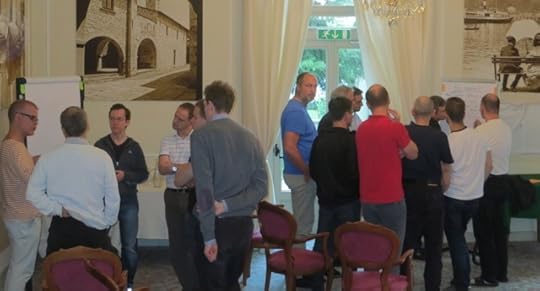
Two small breakout groups
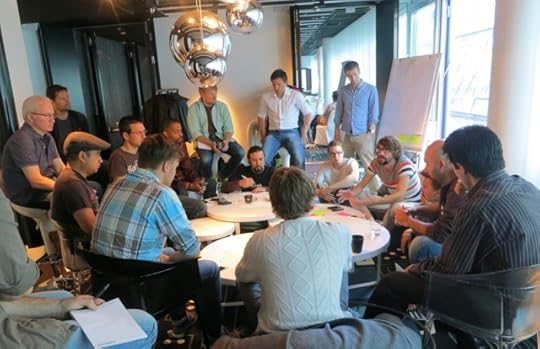
A bigger breakout group
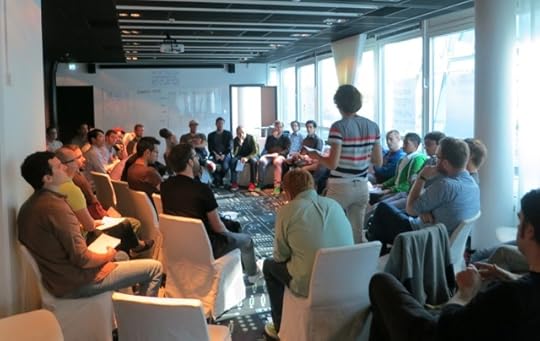
Gathering and sharing
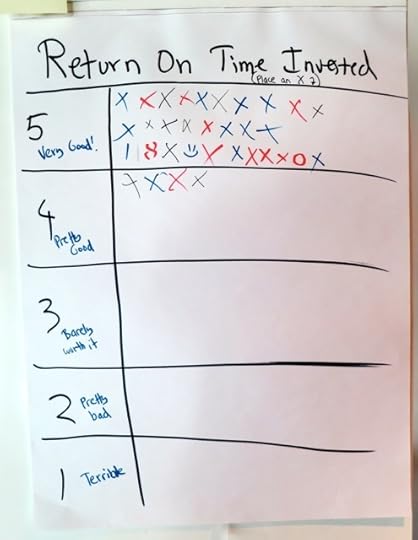
Return on Time Invested – usually all 4s and 5s if the event is done right!
More questions?
Check out my short ebook How to run an internal unconference, or read the wikipedia for Open Space.
If you need help organizing one, feel free reach out to info@crisp.se. Several of us have quite a lot of experience doing these things.
Good luck!
/Henrik
August 23, 2016
Alignment at Scale – slides from my Agile Africa keynote
Here are the slides from my Agile Africa keynote Alignment at Scale (or How to Not become Totally Unagile when you have Lots of Teams). Thanks for a great conference!
And thanks everyone for the Emma greeting, that sure made an 8 year girl very happy 
(Emma was supposed to join me on this trip, but couldn’t make it because I had missed some required paperwork for travelling with minors to South Africa).
June 8, 2016
Spotify Rhythm – how we get aligned (slides from my talk at Agile Sverige)
Here are the slides from my talk about Spotify Rhythm at Agila Sverige.
The talk is about Spotify’s current approach to getting aligned as a company. It covers:
what problem we’re trying to solve, and how we’ve through two other models (OKR and Priorities & Achievements) before arriving at our current model
how we define “Bets” using the DIBB framework (Data-Insight-Belief-Bet)
how we prioritize bets using stack-ranking based on company beliefs and north star goals
how we visualize bets on a kanban-like company level board, and group them into Now – Next – Later columns
how different parts of the company visualize their own bets and align with higher level bets, using interlinked bet boards.
how we synchronize and prioritize our work using different cadences at different levels of the company.
how this model is used to support squad autonomy
our challenges and learnings with this so far
Holy crap how did I manage to cover all that in 10 minutes?! Guess I talked fast 
Some sample slides below.
